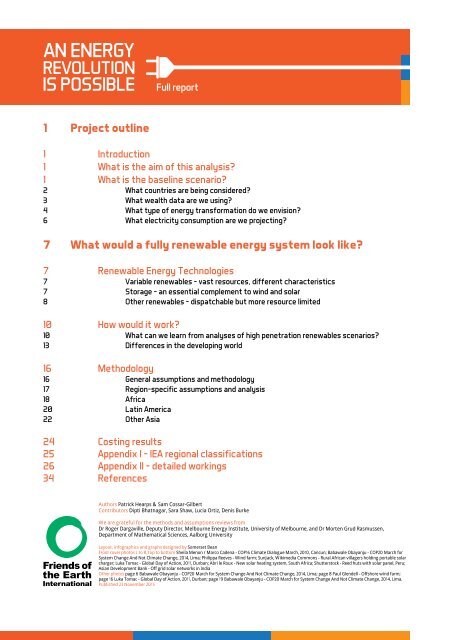AN ENERGY
1SfwbVy
1SfwbVy
Create successful ePaper yourself
Turn your PDF publications into a flip-book with our unique Google optimized e-Paper software.
<strong>AN</strong> <strong>ENERGY</strong><br />
REVOLUTION<br />
IS POSSIBLE<br />
Full report<br />
1 Project outline<br />
1 Introduction<br />
1 What is the aim of this analysis?<br />
1 What is the baseline scenario?<br />
2 What countries are being considered?<br />
3 What wealth data are we using?<br />
4 What type of energy transformation do we envision?<br />
6 What electricity consumption are we projecting?<br />
7 What would a fully renewable energy system look like?<br />
7 Renewable Energy Technologies<br />
7 Variable renewables – vast resources, different characteristics<br />
7 Storage – an essential complement to wind and solar<br />
8 Other renewables – dispatchable but more resource limited<br />
10 How would it work?<br />
10 What can we learn from analyses of high penetration renewables scenarios?<br />
13 Differences in the developing world<br />
16 Methodology<br />
16 General assumptions and methodology<br />
17 Region-specific assumptions and analysis<br />
18 Africa<br />
20 Latin America<br />
22 Other Asia<br />
24 Costing results<br />
25 Appendix I – IEA regional classifications<br />
26 Appendix II – detailed workings<br />
34 References<br />
Authors Patrick Hearps & Sam Cossar-Gilbert<br />
Contributors Dipti Bhatnagar, Sara Shaw, Lucia Ortiz, Denis Burke<br />
We are grateful for the methods and assumptions reviews from<br />
Dr Roger Dargaville, Deputy Director, Melbourne Energy Institute, University of Melbourne, and Dr Morten Grud Rasmussen,<br />
Department of Mathematical Sciences, Aalborg University<br />
Layout, infographics and graphs designed by Somerset Bean<br />
Front cover photos L to R, top to bottom Sheila Menon / Marco Cadena - COP16 Climate Dialogue March, 2010, Cancun; Babawale Obayanju - COP20 March for<br />
System Change And Not Climate Change, 2014, Lima; Philippa Reeves - Wind farm; SunJack, Wikimedia Commons - Rural African villagers holding portable solar<br />
charger; Luka Tomac - Global Day of Action, 2011, Durban; Abri le Roux - New solar heating system, South Africa; Shutterstock - Reed huts with solar panel, Peru;<br />
Asian Development Bank - Off grid solar networks in India<br />
Other photos page 6 Babawale Obayanju - COP20 March for System Change And Not Climate Change, 2014, Lima; page 8 Paul Glendell - Offshore wind farm;<br />
page 16 Luka Tomac - Global Day of Action, 2011, Durban; page 19 Babawale Obayanju - COP20 March for System Change And Not Climate Change, 2014, Lima.<br />
Published 23 November 2015<br />
Project outline<br />
Introduction<br />
This report is the technical report that supports Friend of the Earth International’s summary report with<br />
recommendations and general analysis, also entitled ‘An energy revolution is possible’. To obtain a copy of this<br />
report please visit www.foei.org<br />
What is the aim of this analysis?<br />
The aim of this analysis is purely to calculate an investment cost of providing several regions of the developing<br />
world with 100% renewable electricity, and to compare those amounts with the gross concentrated wealth of<br />
the world’s richest individuals, in order to highlight the need for economic and climate justice.<br />
All values are in 2014 US dollars unless otherwise specified.<br />
It is important to note that the investment cost, representing the additional investment in renewables over<br />
and above what will occur anyway, does not represent the economic cost to society. Investments in power<br />
generation are paid back over time through sales of electricity. Friends of the Earth International believe that<br />
access to energy is a basic human right and a necessary condition of a dignified life.<br />
Greenpeace’s Energy [R]evolution 2015 1 has analysed in detail the entire costs of continuing to rely on fossil<br />
fuel energy up to 2050, compared to switching to 100% renewables. They have found that overall, the cost to<br />
society of the 100% renewables option is cheaper than continued fossil fuel dependence. For while renewable<br />
power may be more capital-intensive than fossil fuel power, which also has ongoing fuel costs. The savings in<br />
avoided fuel costs pay off the higher upfront investment in renewables.<br />
We have calculated for 100% renewable energy (electricity generation) by 2030 to demonstrate that an energy<br />
revolution to tackle climate change is achievable and the financial means exist.<br />
What is the baseline scenario?<br />
The International Energy Agency’s (IEA) World Energy Outlook 2014 (WEO 2014) 2 has been used as the base data<br />
set underlying this analysis. The IEA is considered one of the most authoritative bodies on global energy issues,<br />
working as an entity of the Organisation for Economic Co-operation and Development (OECD), which are<br />
collectively the wealthiest countries on the planet. They collect data on energy use and project future trends for<br />
the entire globe.<br />
The World Energy Outlook 2014 projects that globally, $20 trillion of investment is required in power generation<br />
and transmission infrastructure to 2040 to meet future power demand.<br />
An energy revolution is possible 1


